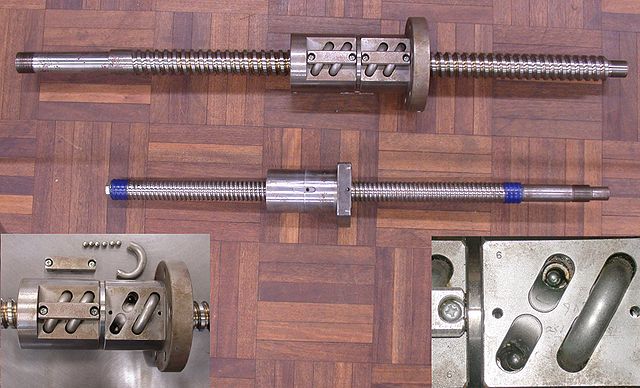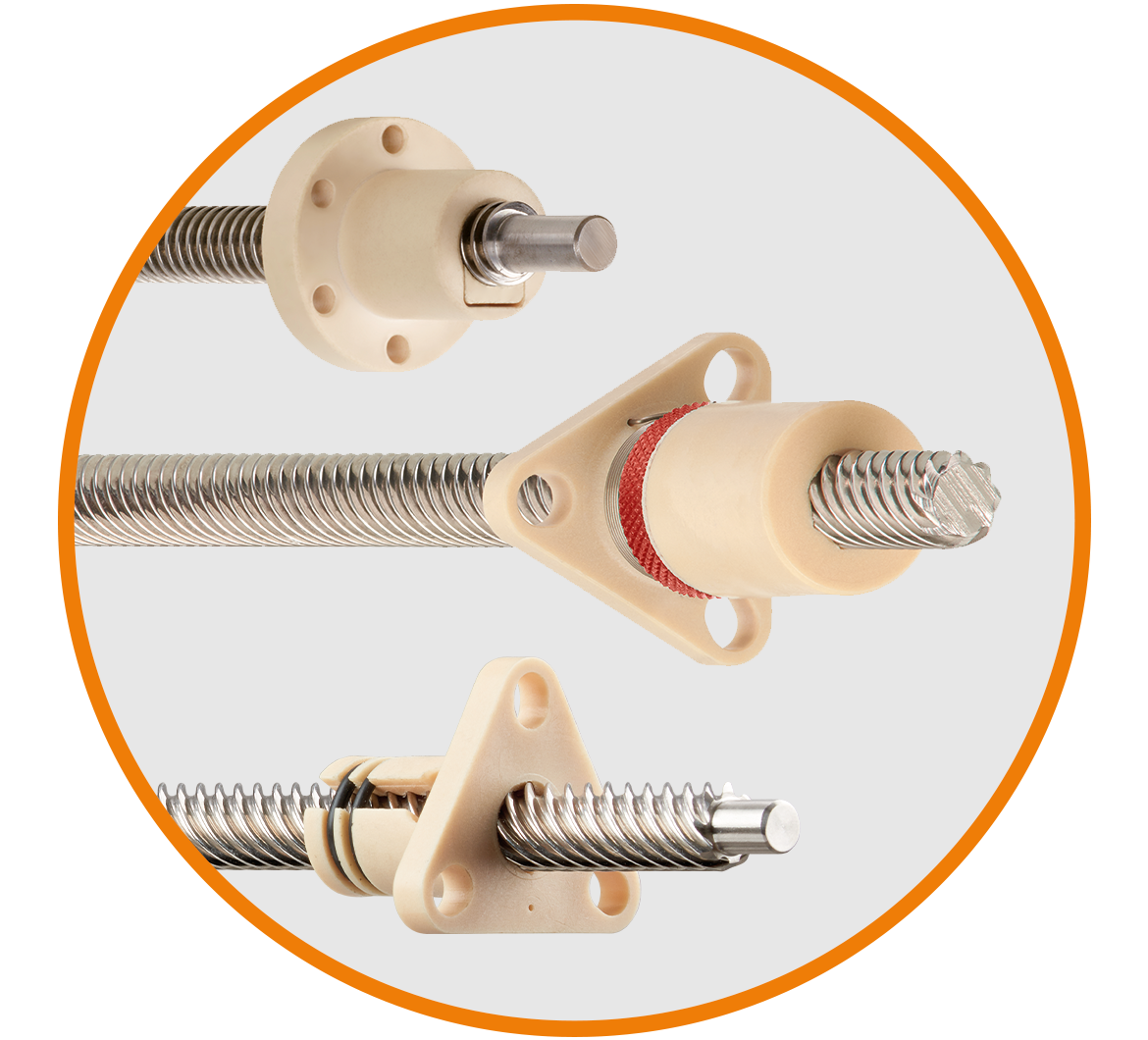Ball Screw vs. Lead Screw: How To Choose The Right One
Within the world of linear motion, screw-driven actuators are one of the most commonly used devices when converting the rotary motion of a motor (stepper, brushless DC, servo, DC) into a linear movement, which is usually guided by a set of linear bearings. More and more often, we are hearing from customers whom are trying to break away from other actuator technologies—in particular air cylinder-driven systems—in favor of the reliability, precision, and ease of use of motorized electrical actuators.
There are two common types of screw-driven systems: Ball screw systems and lead screw systems. Let’s quickly take a look at what may be the better choice for your application.
What is a ball screw?
Ball screws are very similar to recirculating ball bearing systems, using the same rolling properties of ball bearings to convert the motion. Ball bearings roll inside of special grooves cut into the ball screw and nut, allowing for lower friction (and thus a smaller motor), higher precision, and the ability to run under high cycle conditions. Due to the mechanism needed to recirculate the ball bearings, ball screw assemblies tend to be bulkier than lead screw assemblies.

What is a lead screw?
Lead screws, while similar to ball screws in function, are a much simpler assembly. Often, the lead screw itself is made in the rolling process, and the nuts are typically made of injection-molded or machined polymers. Lead screw nuts are available in several geometries including ACME, trapezoidal (metric ACME), miniature metric thread, as well as high helix shapes. Instead of using rolling motion like ball screws, lead screws utilize a sliding motion that generates significantly less noise, particularly when using polymer nuts rather than metal.

These simpler production methods allow for the easy customization of parts, which enables designers to efficiently implement these parts into their projects at a low cost. Lead screw nuts can also be 3D printed, and some materials, like those used in the igus® 3D print service, have exceptional tribological properties and are ideal for producing rapid prototypes.
Advantages of ball screws vs. lead screws
As previously mentioned, ball screws offer more precision and efficiency than lead screws. This allows smaller motors to be used to drive ball screws, reducing costs and weight of the overall system.
Applications where ball screws are ideal are those with high loads and high speeds, as well as those with constant cycling. Some common application areas for ball screws include the automotive and aerospace industries, along with robotic and machine tool applications.
Since lead screws do not back-drive, they are well suited for vertical applications without the additional expense of a brake mechanism. ACME and trapezoidal screws offer the most threads-per-inch compared to other lead screw geometries, and are able to be positioned more finitely in hand-powered applications.
The lack of grease necessary in lead screw assemblies also makes them ideal in applications with hygienic requirements, particularly in the medical, food production, and packaging industries. Finally, lead screw systems come at a lower cost than ball screw systems overall, due to the relative simplicity of their design.
Disadvantages of ball screws vs. lead screws
Ball screws come with all of the same pitfalls as recirculating ball bearings due to their similar design. The most notable downfall of both ball screws and recirculating ball bearings is their reliance on oil or grease as a lubricant, which requires ongoing maintenance to avoid failures. This can also cause issues in bad environments with dirt, dust, wood shavings, etc. Conversely, the lubrication does not lend itself well to sensitive environments in the food and medical industries.
Due to their low friction and ability to be easily back-driven, ball screws are not always ideal for vertical applications where constant motor torque, or even a brake mechanism, may be required to eliminate any chance of the system falling due to gravity, which is often a safety issue.
A final note: due to the metal-on-metal nature of ball screw systems, they are much louder than lead screw nuts, which is something to consider for many applications.
Lead screw systems struggle in high speed applications due to the high RPMs the lead screw would need to spin with in order to move with the fine-pitch leads of the threads. Another potential downside for some applications is the backlash that is present in lead screw nuts. This occurs because lead screw nuts operate under sliding vs rolling conditions where extra tolerances are needed to allow for smooth motion. However, there are options on the market which mitigate the inherent axial clearance of a lead screw system — like the igus zero-backlash and pre-loaded nuts.
Read more: What is screw pitch, and how is it different from screw lead?

Recap: When to choose a ball screw vs. lead screw
When to Choose Ball Screws:
- High loads with high speeds
- Constant Cycling
- High precision
When to Choose Lead Screws:
- Low cost requirements
- Positioning applications
- Applications where grease is a detriment
I hope that this helps simplify the process of choosing. We do provide online product-finders to help determine the suitability of a lead screw nut for your next application, as well as tutorials on how to use them.
Frequently Asked Questions
The key difference lies in the type of friction used to convert rotary motion into linear motion. A lead screw relies on sliding friction between the screw thread and a matching nut. A ball screw uses recirculating ball bearings that roll in the helical raceway, resulting in rolling friction.
Ball screws are significantly more efficient, typically achieving efficiencies of 90% or higher. This high efficiency is due to the low rolling friction of the ball bearings. Lead screws have lower efficiency, generally ranging from 30% to 70%, because sliding friction generates more heat and requires more torque to overcome.
Ball screws are generally better for high-speed, continuous-operation (high duty cycle) applications. Their low friction minimizes heat generation and wear, allowing them to operate effectively at higher speeds and for longer durations. Lead screws, with higher friction and heat generation, are typically limited to moderate speeds and lower duty cycles.
For a comparable size, ball screws typically offer higher dynamic load capacities because the rolling contact of the balls distributes the load more effectively across a larger contact area than the sliding contact of a lead screw. However, lead screws with bronze or specialized polymer nuts can also carry significant static loads.
Ball screws generally offer higher precision and repeatability. They can be manufactured to very tight tolerances and often use a preloaded nut system to virtually eliminate backlash (the axial play between the screw and nut), which is essential for accurate positioning in machine tools and precision equipment. While lead screws can be paired with anti-backlash nuts, they still tend to have more positional error over distance compared to high-precision ball screws.
Lead screws are typically more economical upfront than ball screws. Their simpler design and manufacturing processes (often involving rolling or extrusion rather than precision grinding) contribute to a lower initial cost.
Ball screws require regular, consistent lubrication to maintain efficiency and maximize life, as the rolling elements rely on a thin film of lubricant. They also benefit from protection against contaminants. Lead screws with polymer nuts can often operate effectively without external lubrication, making them suitable for clean environments. However, lead screws with metal nuts typically require lubrication, and all lead screws will experience wear over time, often necessitating nut replacement sooner than a ball screw assembly would require replacement.
Neither a ball screw nor a lead screw is universally "better"; the optimal choice depends entirely on the specific requirements of the application.



